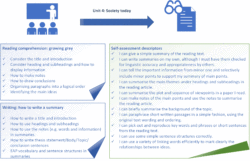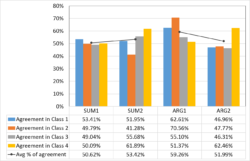Research output
Designing assessment grids
Selecting and designing self-assessment descriptors
- Selecting descriptors from levels A2-C1 from the ELP bank according to students’ existing English language proficiency level
- Selecting descriptors on summaries and argumentative essays in line with the existing syllabus.

- Three emoticons were used for students to assess their writing proficiency on three different levels for each descriptor since they are:
- widely used in social media
- continuous reflection of learning as in daily life
- distinguished from summative assessment using numbers
Training in using ELP descriptors for self-assessment
- Raising students' awareness of strengths and limitations of self-assessment
- Tutors explaining the ELP descriptors and demonstrating how to use them for assessment
- Students using the ELP descriptors for self-assessment
Collecting learners' and tutors' perceptions of the ELP descriptors
- student survey on their perceptions of the accessibility and usefulness of the descriptors for self-assessment
- tutor reflective logs on their perceptions of the accessibility of ELP descriptors for students
Key findings
- Students' perceived accessibility of ELP descriptors: a relatively low accessibility level.
- Main reasons for low accessibility: difficult wording, low English language proficiency, difference between English language and Chinese language, limited understanding of academic writing
- Students’ perceived accessibility of the self-assessment grid was echoed by the two tutors in their reflective logs
Modifying assessment grids
Based on students' and tutors' reflection on the descriptors, the following modifications were made to the assessment grids:
- using bilingual versions to maintain English learning opportunities and increase the accessibility level
- Reducing the assessment load by distributing descriptors across sessions
- reducing technical terms and difficult wording
- relocating similar descriptors
Applying assessment grids and comparing self- and teacher assessment ratings
Focuses of the self-assessment
The four self-assessment sessions for students were conducted with the modified grids successively. Teacher assessment of the same tasks was conducted by using the same descriptors by changing 'I can' statements to 'she/he can' statements.
| Self-assessment session | Assessment focuses |
| Session 1 |
Constructing summaries (9 modified items) |
| Session 2 |
Language use in summaries (12 modified items) |
| Session 3 |
Constructing argumentative essays (7 modified items) |
| Session 4 | Language use in argumentative essays (14 modified items) |
Key findings
Agreement between self- and teacher assessment
- Inter-rater reliability analysis found significant agreements between self- and teacher assessment ratings on most descriptors in all tasks.
- Across the four tasks, students tended to over-estimate their writing competence, compared with their tutors.
- Slight discrepancies of the agreement percentages existed among tasks and classes.

Usefulness
For students:
- 96.9% and 97.9% of the students confirmed the usefulness of the pre-modified and post-modified ELP descriptors for their writing, respectively.
- Nearly 60% students in the pre- and post-assessment questionnaires reiterated the usefulness of the descriptors for helping them identify their writing weakness.
- Students expected follow-up activities to address their weak areas in writing to increase the usefulness of the descriptors.
For tutors:
- Both tutors believed that the descriptors had helped their students be aware of their writing weakness and expanded their understanding of what a good piece of writing should be.
- The descriptors developed tutors' understanding of essential facets of good summaries and argumentative essays, and therefore informed their teaching.
- Tutors realised that students were capable of assessing themselves which would lead to future use of similar activities.
Feasibility
For students:
- Students perceived a moderate feasibility level of the descriptors for self-assessment activities. Most students (60.8%) held a neutral position towards the feasibility of the ELPs for self-assessment activities.
- Four main factors could affect feasibility: (1) lack of experience of self-assessment; (2) difficulty in understanding the descriptors; (3) uncertainty about their own language proficiency; (4) limited language proficiency.
For tutors: the modified ELP descriptors were feasible according to their observation during the self-assessment activities; however, the feasibility level was affected by students’ committment to the self-assessment activities.
